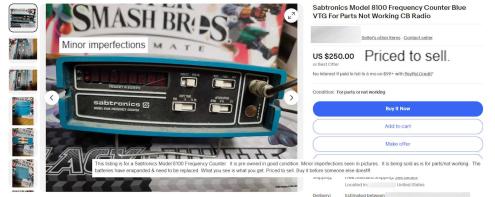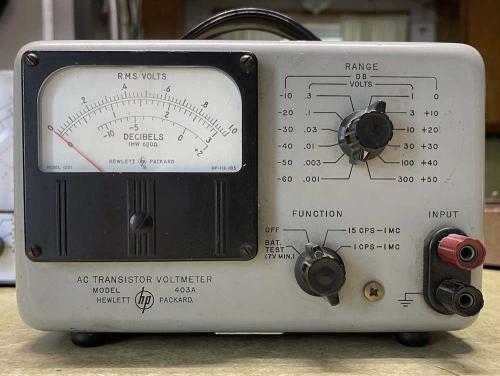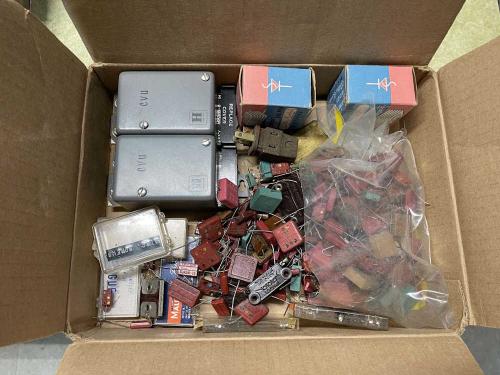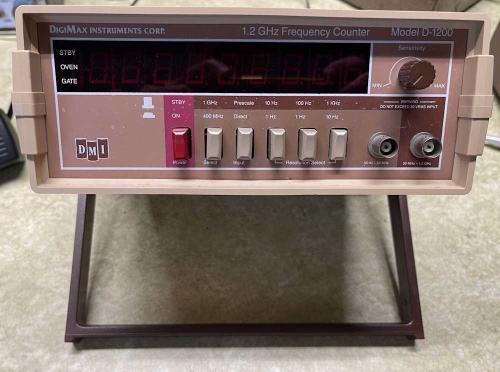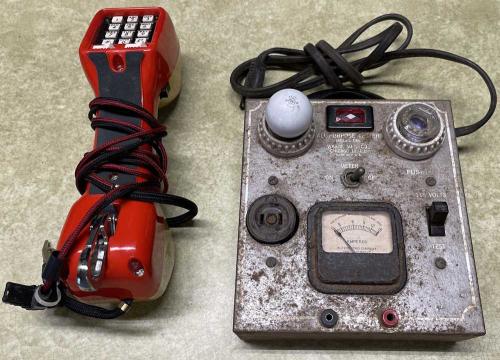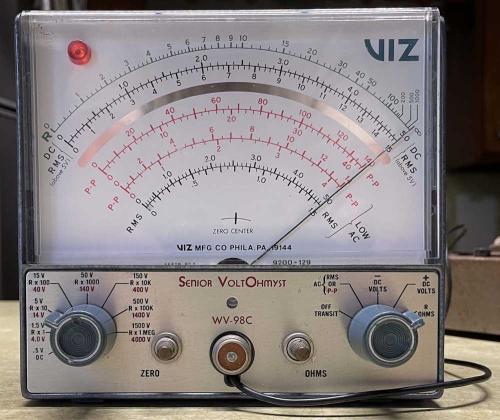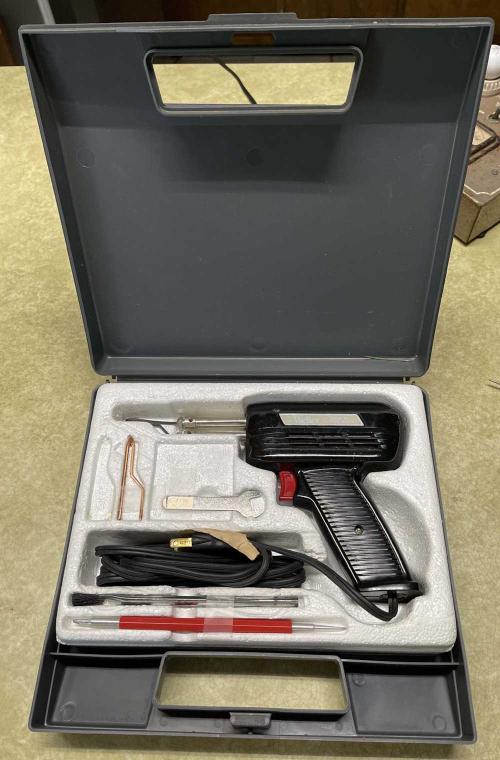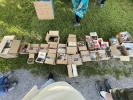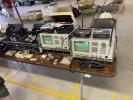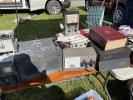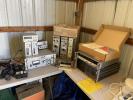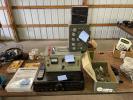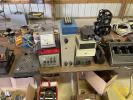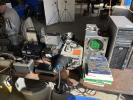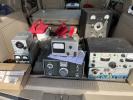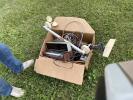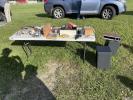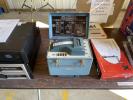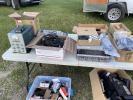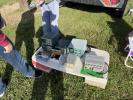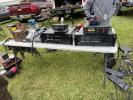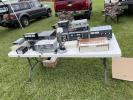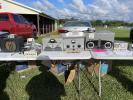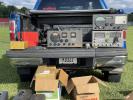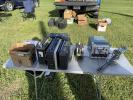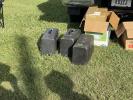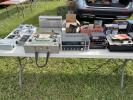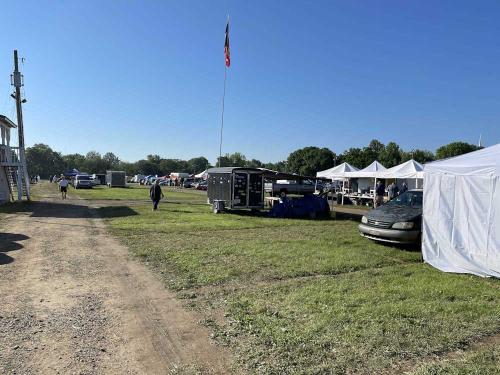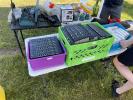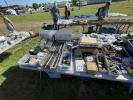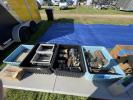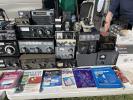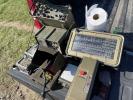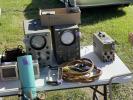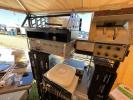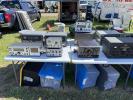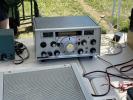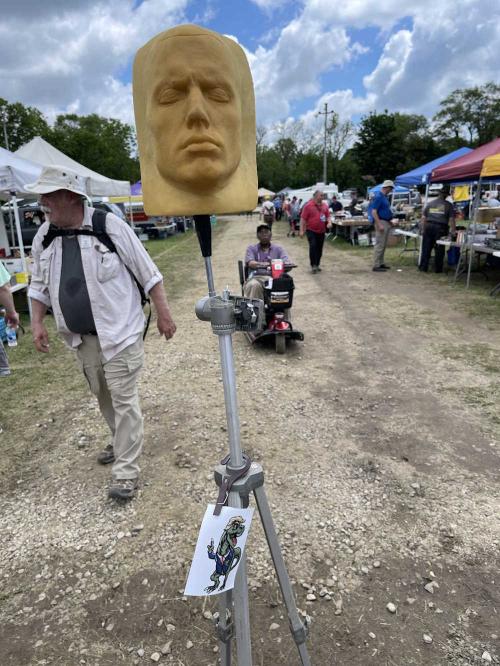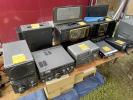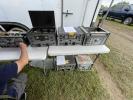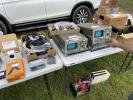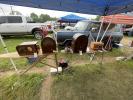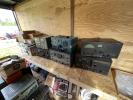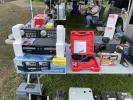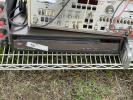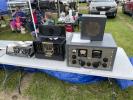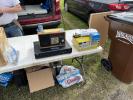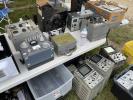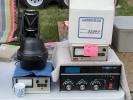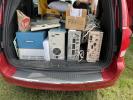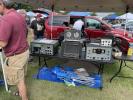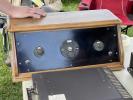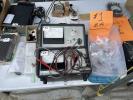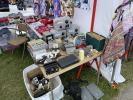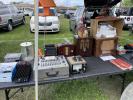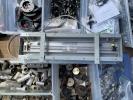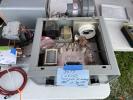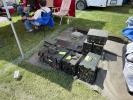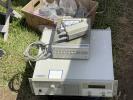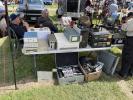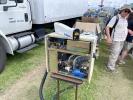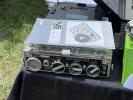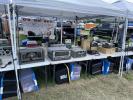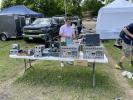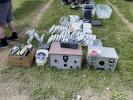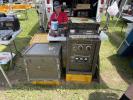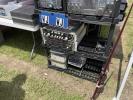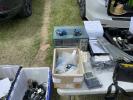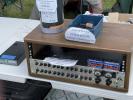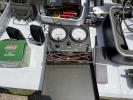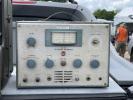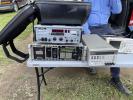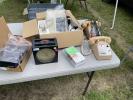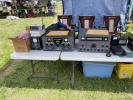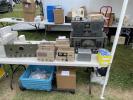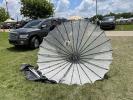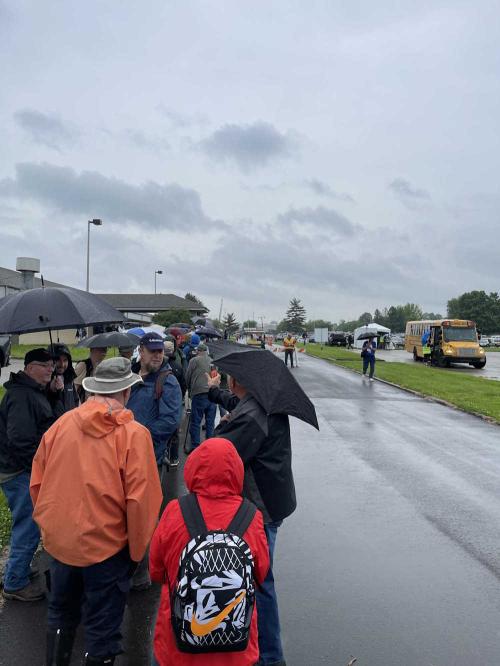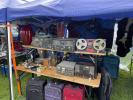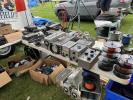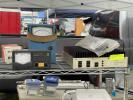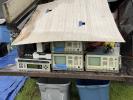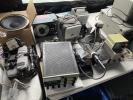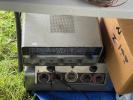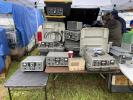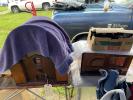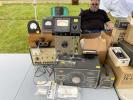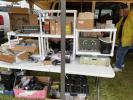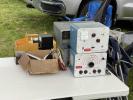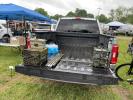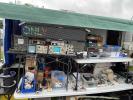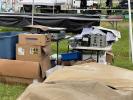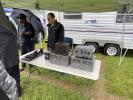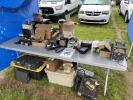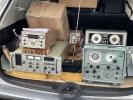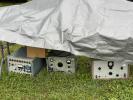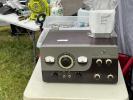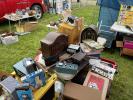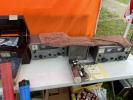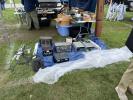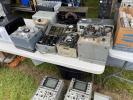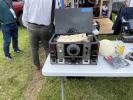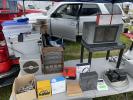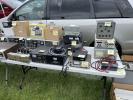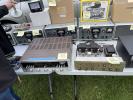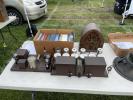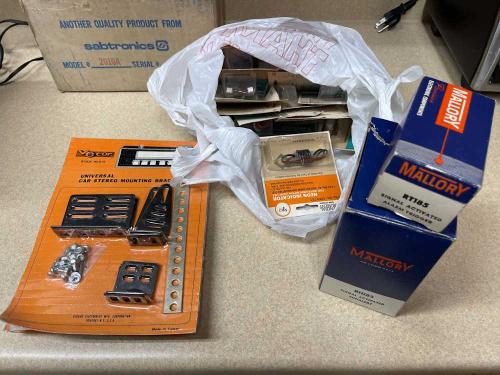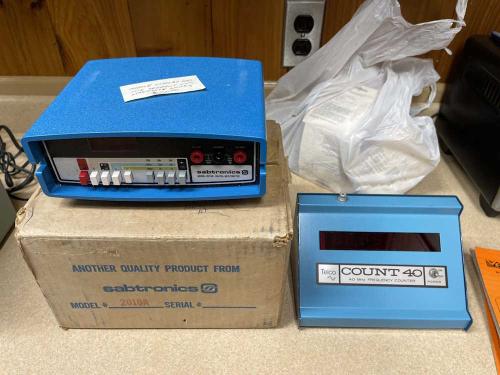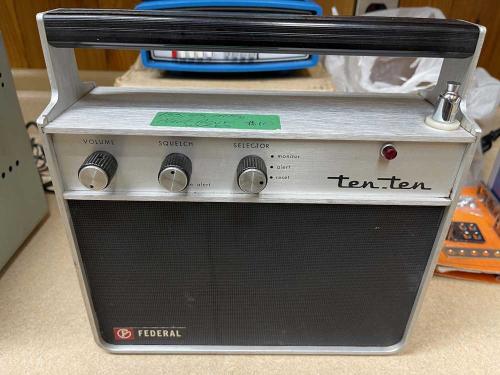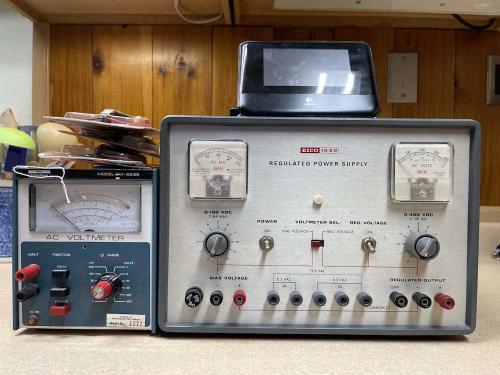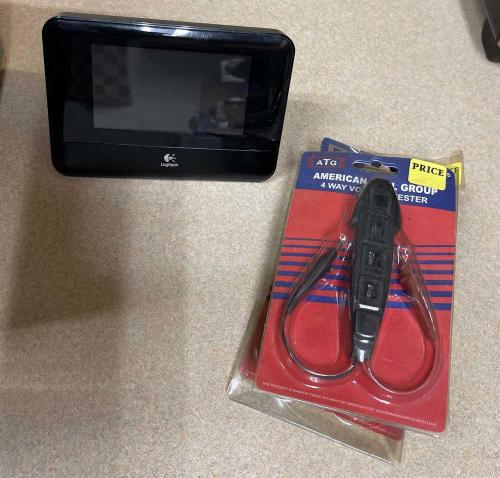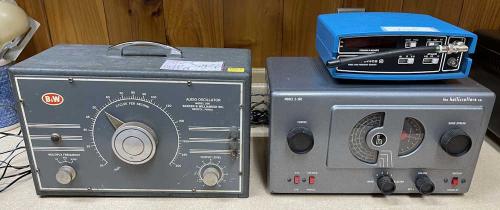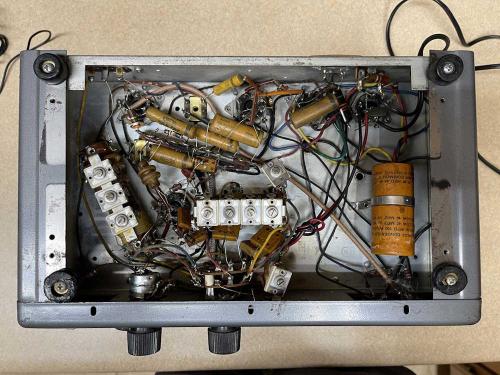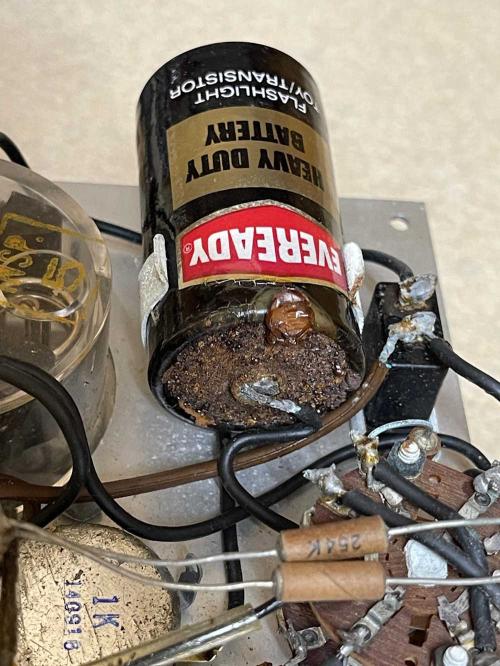- 2024
- Jun
- 13
Minor imperfections. Priced to sell.
I picked one of these guys up at Dayton for $20, modified to work in the 2M band. Figured, hey! I’ll pick up some parts units.
For some reason, a non-working device with a (hopefully intact) broken display cover, swollen batteries (and quite possibly corroded inside,) no battery cover, no (oddball) power adapter, and covered with dirt for $250 doesn’t inspire me to add “Priced to sell” in the description. Especially when the device has been superseded many times over with modern equipment at lower prices.
At least it’s free shipping!
- 2024
- Jun
- 9
Breezeshooters 2024 - What I brought home.
I tried to limit myself to things I could possibly use, and I (mostly) did so. We’ll see if all these things actually work, or if some of them need some work.
This HP AC Transistor Voltmeter Model 403A seems to be in good condition, and has a Westinghouse tag on the back. I can’t really test it because it has some odd battery requirements. It looks to need 5 mercury cell batteries - 2 4V batteries, and 3 1.35V batteries in a configuration that provides bias and + / - voltages. These are unobtainable, so a small supply may be in order if I actually want to use this thing.
This came from a vendor that had boxes of parts. One part was $2, if you took the whole box it was $1. So…I took a box of mica capacitors and some other parts. High voltage mica caps can always come in handy.
This DigiMax Instruments D-1200 counter claims to go to 1.2GHz, and has lamps for an ovenized reference on it. It’s awfully light, but it does light up. I need to get a signal in it to see if it’s actually counting, or if it’s just spitting out garbage.
The Harris-Dracon butt sett was picked up becaue it was cool looking. I don’t know what I’ll use it for, but whatever. The Waage All-Purpose Tester Model 066 test box was a dollar - it’s mostly just an ammeter you can switch out, with a fuse and a lamp for testing the AC line. It’s pretty rusty, but looks clean inside. Who knows where this will end up.
This VIZ Senior VoltOhmist WV-98C meter seems to be operational, and has a case you could kill a poodle with. It’s a two-tube unit, using a 6AL5 Dual Diode and a 12AU7 amplifier. It’s small enough to go on the bench instead of the giant EICO VTVM currently there.
This Weller solder gun has all of the tools with it, and is one of the units made in the USA. I have a couple of these, they come in handy soldering chassis items.
That’s this year’s haul. I tried to limit myself to smaller items I could use, and I mostly succeeded. There were a lot of larger items that I wanted, but left there since I don’t have room for them. In all, I didn’t spend a lot and brought home some neat things.
Next show is either the Van Wert, OH show - that’s a long drive and may not be in the cards - and/or the Columbus, OH show which is a lot closer to me and much easier to attend. Either way, stay tuned for pictures from those shows, and I’ll see you there!
- 2024
- Jun
- 9
Pictures from Breezeshooters 2024 Hamfest.
It was raining where I was, and threatened rain all the way to the show - but when we arrived, the sky had cleared and it was a sunny, slightly breezey 71F. Essentially, perfect conditions for wandering the aisles. While I didn’t see some of the things I hoped would show up this year, there was still quite a bit to look at. I spent a couple hours wandering the show before heading out for some lunch.
The usual mix of equipment showed up here, and a few things managed to wander home with me. This is what I saw at this year’s show:
.
Next show will probably be the Columbus, OH hamfest, although there are some happening before that. Regardless, I’ll (maybe) see you there!
- 2024
- May
- 20
Hamvention 2024 - Sunday’s Pictures.
The last day of the show was hot and dry.
Sunday was a slim day - many of the vendors pack up Saturday evening, but maybe 1/5 were still on the grounds, not counting the exhibit buildings. Lots of reduced price deals and some free stuff were around today, and I still managed to bring home too much. Today’s lunch was Bourbon Chicken and a milkshake - a bottle of sauce managed to make it home as well. In all, this was a good show even if Friday was a bit messy. It’s also the first year I didn’t go through the exhibit halls, but there’ s nothing in there I needed this year.
Here’s what I saw this year on Sunday:
.
All three days of pictures:
Friday https://wereboar.com … 24-fridays-pictures/
Saturday https://wereboar.com … -saturdays-pictures/
Sunday https://wereboar.com … 24-sundays-pictures/
Links to all the things I drug home this year:
Friday https://wereboar.com … d-in-my-car-i-swear/
Saturday https://wereboar.com … it-followed-me-home/
Sunday https://wereboar.com … t-because-its-cheap/
- 2024
- May
- 20
Hamvention 2024 - Saturday’s Pictures.
Saturday was perfect. It was about 80F, partly cloudy, and the grounds had started to dry out enough you could walk and reasonably expect to stay on the surface.
And the weird stuff came out as well…
All the vendors that toughed out the previous day were open displaying all kinds of electronic wonders. A steak tip dinner was had for lunch, and it was awesome as always - much better than the burnt burgers and nasty nachos offered by the other venue. We spent about half the day going through the flea market looking for things to take home.
Here’s what I saw this year on Saturday:
.
All three days of pictures:
Friday https://wereboar.com … 24-fridays-pictures/
Saturday https://wereboar.com … -saturdays-pictures/
Sunday https://wereboar.com … 24-sundays-pictures/
Links to all the things I drug home this year:
Friday https://wereboar.com … d-in-my-car-i-swear/
Saturday https://wereboar.com … it-followed-me-home/
Sunday https://wereboar.com … t-because-its-cheap/
- 2024
- May
- 20
Hamvention 2024 - Friday’s Pictures.
Friday promised to be a rainy day, and it wasn’t a lie. The RADAR showed rain, and lots of it!

And it was wet…
The line ride was soaked.
But that didn’t stop me from playing in the mud like a happy little wereboar. There were still plenty of vendors open with tents over their wares, and I still brought home way too much. I spent about 4 hours wandering the wet ways, and of course it decided to stop the minute I was finished! I was soaked by then, and ready to go, but Saturday and Sunday awaited.
Here’s what I saw this year on Friday:
.
All three days of pictures:
Friday https://wereboar.com … 24-fridays-pictures/
Saturday https://wereboar.com … -saturdays-pictures/
Sunday https://wereboar.com … 24-sundays-pictures/
Links to all the things I drug home this year:
Friday https://wereboar.com … d-in-my-car-i-swear/
Saturday https://wereboar.com … it-followed-me-home/
Sunday https://wereboar.com … t-because-its-cheap/
- 2024
- May
- 19
Hamvention 2024 - Sunday’s Stuff I Didn’t Need (Ok, I’m just buying it because it’s cheap!)
Sunday was much like Saturday, except warmer. 85F and no rain, the infield was dry, and crowds were low - of course, many vendors pack up the night before. All the food vendors were still there, so I hit the Bourbon Chicken stand and took home a bottle of sauce after eating my delicious chicken.
There’s a vendor that always has tables of stuff for a dollar. I always spend a few dollars here, this year I brought home a bag of indicator lamps of differing styles, some packs of mounting brackets, and a couple of oddball alerting devices. The bag also contains some pin jacks from another vendor that were 2 for a quarter, so I grabbed a handful.
I can’t not buy a voltmeter, so this Sabtronics unit compliments the counter I got Friday. The seller claims it works with a bad segment, that will just be a display replacement. The cool thing about this is it has all documentation, including the shipping box, invoices, and correspondence between the buyer and seller. It cost $2.21 to ship from Texas to Missouri in 1979!
The counter is just…a counter. It’s in an odd case. It’s from the 1970s. I have no idea if it works. That’s for another day.
Last is this odd radio. It’s a Ten Ten brand, manufacturing by Federal Signal. It monitors one frequency. Just one. I’m hoping I can convert it to work on the weatherband, which may be as simple and changing a crystal. We’ll see.
That wraps up the 2024 Dayton Hamvention. General pictures of the event coming soon, I took quite a few this year!
Links to all the things I drug home this year:
Friday https://wereboar.com … d-in-my-car-i-swear/
Saturday https://wereboar.com … it-followed-me-home/
Sunday https://wereboar.com … t-because-its-cheap/
- 2024
- May
- 19
Hamvention 2024 - Saturday’s Stuff I Didn’t Need (mom it followed me home!)
Saturday was a good day at the Hamvention. It was warm, things were drying out, and everything was open. A few vendors appeared to have left, but there’s always some that only attend Friday, expecting it to be the big day.
The mix of products has changed over the years. Gone are the big stacks of old test equipment, piles of old radios and televisions, and the endless sea of Watkins-Johnson equipment. CBs have faded as well from their peak a few years ago, and computer equipment is all but gone save for a few “classic” machines and newer hard drives that got replaced in the never-ending “moar stoarage!” quest. Hobby gear from the 60s seems to be common right now, with big radio gear still being common but lessening.
I picked up a few things Saturday:
I picked up this Eico power supply. It’s designed for tube work, providing 400VDC and 150VDC for plate and biasing. There was a second one, not working, and I was going to offer on both but the dead one sold first. Probably for the same thing I was going to use it for - parts.
The little Heathkit meter is AC only, but the meter goes to the middle when it’s turned on. Something leaky or shot, most likely. It was last calibrated in 1995, was used by Southwestern Bell, and the cal house was in Dayton. Kind of a cool thing.
A manual for both items is in order before use.
This Squeezebox Touch was in a box of random devices. Logitech used to have this awesome music player system that you ran on a server at your house, and you could connect multiple music players to it that played streams or your local library. They discontinued it because I guess you can’t sell ads in a service you run yourself. Regardless, the players still work fine and this clean example of one of the touchscreen models was cheap. I need to try it out, if it’s dead then oh well.
The other items are AC line testers. Unlike most, these have 120, 220, 380, and 440 lamps. At a buck each, I bought 3 and will toss them in the toolbag.
That’s all for Saturday, I was planning to (and did) go back on Sunday. I picked up a few more items to take home because vendors were willing to deal so they didn’t take it home. Stay tuned!
Links to all the things I drug home this year:
Friday https://wereboar.com … d-in-my-car-i-swear/
Saturday https://wereboar.com … it-followed-me-home/
Sunday https://wereboar.com … t-because-its-cheap/
- 2024
- May
- 17
Hamvention 2024 - Friday’s Stuff I Didn’t Need (but it jumped in my car I swear!)
This year’s show started out rainy, and it rained until I was done browsing the flea market about 4 hours after open. Of course!
Really, the only thing I wanted out of the show this year was to find a Hallicrafters S38C. I had one of these years ago, and gave it to a family member. They swear they gave it back, but I don’t have it and I don’t remember giving it away. Not a big deal, it was a pretty poor example of the type but it did have a manual with it. I ended up coming home with a frequency counter - I need one to fix my other one that suddenly stopped counting, and got a good deal on a boat anchor of a signal generator. I also found what I came to the show for - an S38C.
The Frequency counter is nothing special, just a counter. It works. I saw it working at the show, so no problems.
The gods smiled on me because this S38C was sitting at a booth with a couple of other similar radios that an older gentleman was selling because he just didn’t have the time or interest anymore. It’s in great shape for the age. It’s missing the back, of course, and a knob was kind of busted. Not a big deal, the case and innards are in excellent condition.
Everything inside is completely untouched. Bask in the glory of leaky wax paper capacitors and bumblebombs.
The filters are bad, of course. That’s expected, and the 150V capacitors won’t be too hard to acquire. If I can find some at the show tomorrow that aren’t super goodly chinesium, I’ll get them - otherwise, a Mouser order is in my future.
future me note: it has bad IF transformers.
The last item is the signal generator. It’s in ok shape for the age. What caught my eye is the beautiful flywheel tuning dial. Just a pleasure to spin and turn. It works, but has some issues - the signal kind of fades in and out. No tsure what’s going on here, I’ll open it later and take a look. However, when it does work the signal is quite nice.
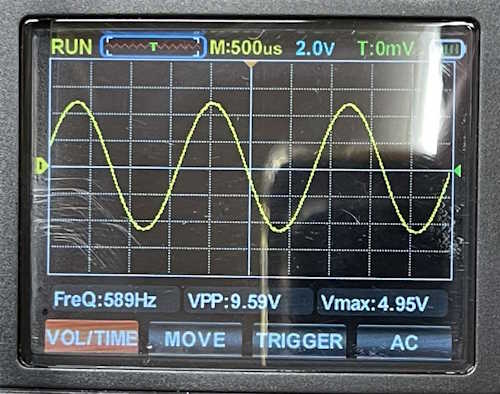
future me note: it wasn’t worth repairing.
That’s it. There’s one piece I told myself if it’s there I’ll get it tomorrow, so we’ll see.
Links to all the things I drug home this year:
Friday https://wereboar.com … d-in-my-car-i-swear/
Saturday https://wereboar.com … it-followed-me-home/
Sunday https://wereboar.com … t-because-its-cheap/
- 2024
- May
- 13
My favorite part of opening old devices is…
taking the cover off and finding an old battery inside. One that probably is as old as me.
At least it’s not an alkaline battery this time. But you know, the best ones are coated with brown sugar.
